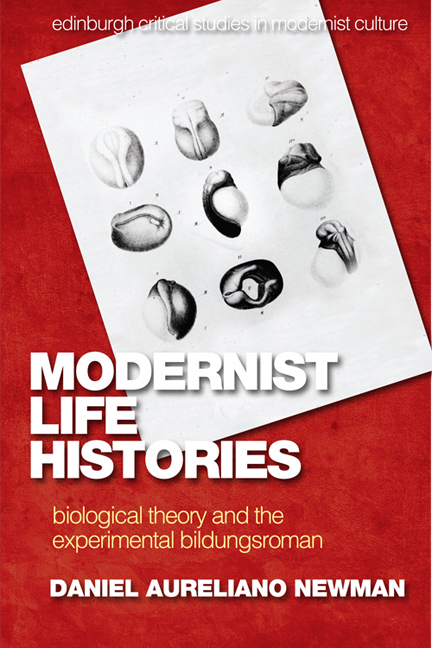Book contents
- Frontmatter
- Contents
- List of Figures
- Preface
- Acknowledgements
- Series Editors’ Preface
- List of Abbreviations
- Introduction
- 1 Bildung, Biology and the Narrative Structure of Development
- 2 A Portrait of the Artist as a ‘Biologist in Words’: Language, Epiphany and Atavistic Bildung
- 3 Mendelian Inheritance, ‘Eternal Differences’ and Entropy in Howards End
- 4 ‘Tampering with the Expected Sequence’: Heterochrony and Sex Change in Orlando
- 5 Anachrony, Neoteny and the ‘Education of an Amphibian’ in Eyeless in Gaza
- 6 Beginning Again: Darwin’s Caterpillar from George Eliot to Beckett
- Conclusion
- Bibliography
- Index
4 - ‘Tampering with the Expected Sequence’: Heterochrony and Sex Change in Orlando
Published online by Cambridge University Press: 23 April 2021
- Frontmatter
- Contents
- List of Figures
- Preface
- Acknowledgements
- Series Editors’ Preface
- List of Abbreviations
- Introduction
- 1 Bildung, Biology and the Narrative Structure of Development
- 2 A Portrait of the Artist as a ‘Biologist in Words’: Language, Epiphany and Atavistic Bildung
- 3 Mendelian Inheritance, ‘Eternal Differences’ and Entropy in Howards End
- 4 ‘Tampering with the Expected Sequence’: Heterochrony and Sex Change in Orlando
- 5 Anachrony, Neoteny and the ‘Education of an Amphibian’ in Eyeless in Gaza
- 6 Beginning Again: Darwin’s Caterpillar from George Eliot to Beckett
- Conclusion
- Bibliography
- Index
Summary
Something that everyone disapproved of, something that linked the present to that early continuous development, before school, war and a thousand tiny barriers had divided her spirit into a dozen diverse strands.
– Bryher, Two Selves (2000: 266)When, in the middle of Virginia Woolf's Orlando, the protagonist awakens to find ‘he was a woman’ (O 137), the narrator does not linger on causes and explanations. Remarkably casual in the face of the transformation, she offers merely the ‘simple fact’ that ‘Orlando was a man till the age of thirty; when he became a woman and has remained so ever since’ (O 139). There is then little to add, other than to normalise the metamorphosis further: ‘the change seemed to have been accomplished painlessly and completely and in such a way that Orlando herself showed no surprise at it’ (O 139). Woolf's narrator admits ‘many people’ will think ‘such a change in sex is against nature’, but she refuses to sensationalise or explicate the event, leaving it to ‘other pens [to] treat of sex and sexuality’ (O 139). As to the identity of these ‘other pens’, she offers only a hint, albeit an intriguing one: ‘Let biologists and psychologists determine’ (O 139).
Apparently dismissing science, she may also be inviting us to take her at her word. On information pointedly omitted by the narrator, ‘biologists’ might have something to say. Jean-Jacques Mayoux thought as much, noting in a review of Orlando that ‘this change of sex’ and the fact that ‘sexes intermix’ reflect ‘the very opinions of contemporary biology’ (1930: 119). Mayoux says nothing else on the topic, but he is right. Beginning in the 1910s with Richard Goldschmidt's moth-breeding experiments, the study of sex determination would become by the early 1920s one of ‘the most active lines of work’ in genetics and sexual physiology (Gates 1921: 571). It would radically reimagine sex as fluid and variable, and though its findings were based mainly on insects and frogs, they inevitably implicated humans. ‘The fact of intersexuality’ in animals very different from us, argues Julian Huxley, ‘shows us that we may have to revise not only our moral judgments but our legal practice with regard to various abnormalities of sex in human beings’ (1922c: 241).
- Type
- Chapter
- Information
- Modernist Life HistoriesBiological Theory and The Experimental Bildungsroman, pp. 108 - 133Publisher: Edinburgh University PressPrint publication year: 2018



